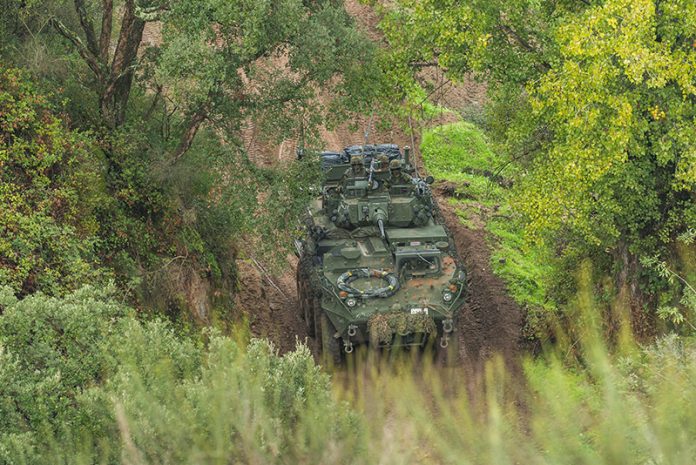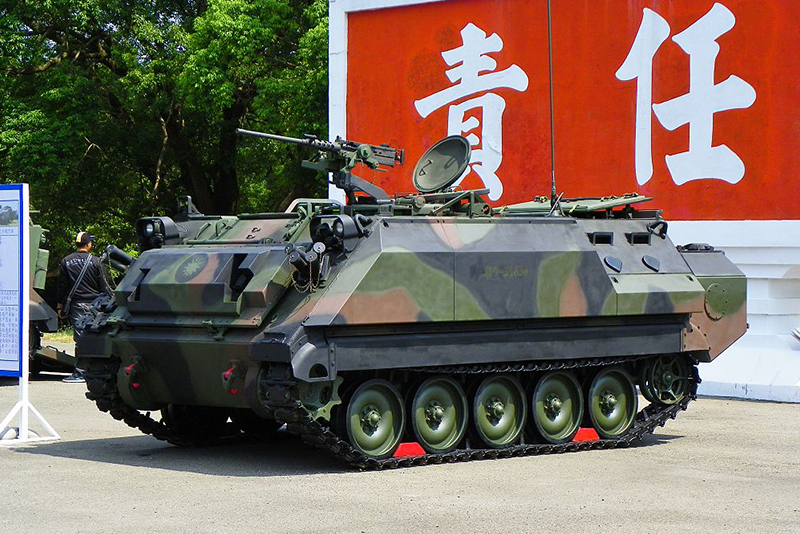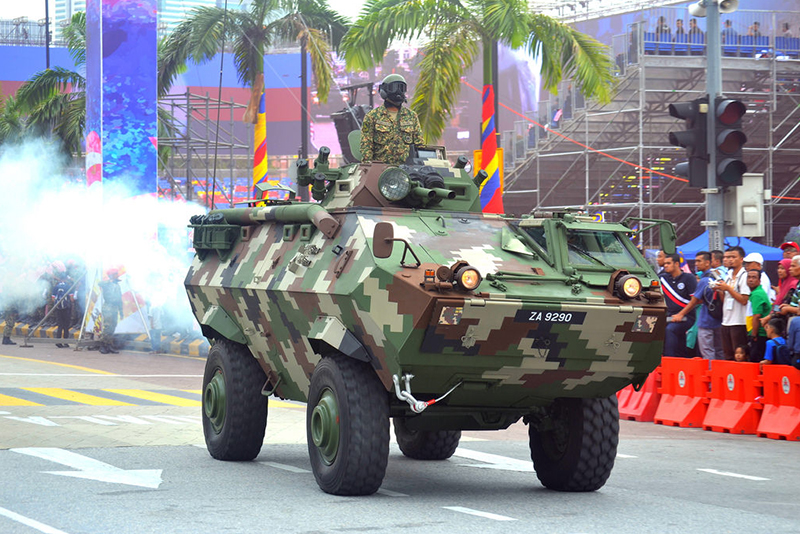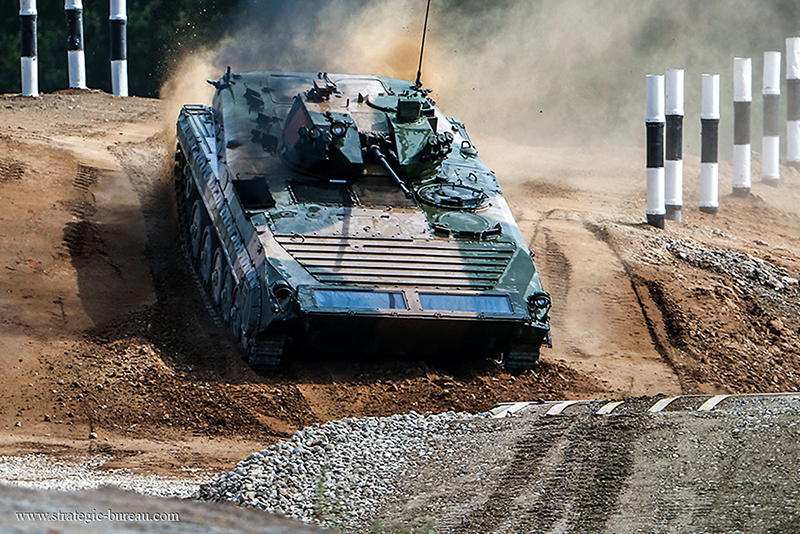
The desire to retain and operate a selection of armoured combat vehicles in Asia Pacific is encouraging local industry to get ‘in on the act’.
The range of armoured combat vehicles available to the modern soldier include direct fire vehicles centred on main battle tanks (MBTs), ‘light tanks’ and tank destroyers, as well as infantry carrier vehicles (ICVs), infantry fighting vehicles (IFVs), and armoured reconnaissance vehicles (ARVs).
These can have tracked or wheeled running gear but in either case are designed to move on and off-road and to manoeuvre to gain advantage over the opponent. Vehicles can mount armament ranging from large calibre cannon to medium calibre auto-cannon or machine guns. Each is protected to some level by armour but may also incorporate a range of other protective measures. They typically have optical sighting systems and fire controls that provide accurate engagement of various targets at maximum ranges and in various battlefield conditions. Combat vehicles offer significant offensive and defensive capabilities and when properly employed in conjunction with other combat arms like anti-tank guided missiles, mortars, artillery, and attack helicopters as well as aircraft, can dominate the battlefield.
Armoured combat vehicles, however, are costly both to acquire and operate/maintain. Warfare, especially armoured manoeuvre warfare, is dynamic with threats evolving, new more lethal and capable weapons being introduced and technologies being perfected and fielded that challenge existing combat systems. The diverse range of threats that they face include long range anti-tank missiles, hand held anti-armour weapons, mines and improvised explosive devices (IED) As ever, industry equally responds with improvement, upgrade and modernisation programmes for these vehicles.
These modernisation efforts have overall been remarkably successful. Some projects embody the phased introduction of improved capabilities as new technologies, sub-systems and components become available. The addition of ‘A1’ or other number to the original designation often reflects this upgrade approach. The Leopard2 A6 indicates an improved version of the earlier Leopard2 MBT. This ‘block’ improvement process is often used by armies to upgrade their existing fleets through a rebuild process where fielded vehicles are returned to the factory or depot and then fully disassembled and rebuilt to the new standard. The US Army M1 Abrams MBT, placed in service in 1980, has undergone a number of such efforts and remains in use with major changes.
Considering the cost associated with replacing an army’s combat vehicles, a Service Life Extension Programme (SLEP) offers a way to extend the life of existing vehicles by regaining and sometime improving reliability. SLEPs take advantage of the work process to replace components and sub-systems not only with new equipment but often the latest and improved versions. Installing new power packs (engine, transmission and drives), suspensions, and today’s digital open architecture controls are common. These efforts are often tailored by industry and militaries to also address problems and lessons learned during operations. The US Marines Assault Amphibious Vehicle AAV7 fielded in 1970s and Light Armoured Vehicle (LAV) introduced in 1983 have both undergone several SLEPs allowing their use to be extended through 2030 and 2035 respectively.
Finding and implementing critical improvements – sometimes just a single issue – can affect the ability to successfully employ the combat vehicle and prevent casualties. If this is identified during a particular ongoing deployment, industry is required to conduct rapid development and fielding. The US operations in Iraq saw a number of such efforts in response to the widespread use of IEDs and rocket propelled grenades (RPGs) particularly in close urban combat operations. For examples, fitting bar or slat armour to the Bradley IFV and Stryker ICV could be accomplished in the field through the design of a special double V-hull (DVH) helped to defeat mines and IEDs which the original flat bottom hull would not. Wendy Steiger, the GDLS programme manager revealed: “The complexity of incorporating the DVH necessitated a complete chassis replacement so the Army incorporated into a ‘reset’ programme in which old Strykers were turned in and replaced by DVHs in ‘zero miles/zero hours’ condition. The old vehicles were then used as the basis for additional DVHs. This also allowed the incorporation of Engineering Change Proposals (ECPs) that further improved the vehicles abilities and reliability.”
Modernisation, upgrade and improvement is a tool employed by virtually every army worldwide but has been actively utilised over the past few years by a number of Asian-Pacific army’s in particular to enhance their armoured force’s capabilities. The process offers a cost effective way to update current fleets and to recover reliability, meet current threats and extend the useful field life of their vehicles. A number of such programmes are underway with many levering collaboration with long establish combat vehicle developers and suppliers and local industry.
Singapore
Singapore’s Army (Tentera Singapura) has worked with local industry partner ST Kinetics to achieve a strong local defence armament capability. This has included the modification and upgrade of acquired foreign manufactured combat vehicles. Its M113A2 Ultra IFV used the M113A1 which was then upgraded to the A2 standard and adding armour and a twin 40mm automatic grenade launcher/.50 calibre heavy machine gun in a protected weapon station. Alternately a Rafael Overhead Weapon Station with a M242 25mm Bushmaster auto-cannon was used. According to ST Kinetics the ‘ M113 Ultra provided the basis for the later Bionix 40/50 and Bionix 25 IFVs which constitute the majority of the Army’s tracked combat vehicle fleet.”

Indonesia
The Indonesian Army (Nasional Indonesia Angkatan Darat – TMI-AD) has for several years been modernising its armoured force. It had added over 100 Leopard 2A2RI (Republic of Indonesia) MBTs customised to TMI-AD requirements. Acquisitions from Rheinmetall have added 42 Marder 1A3 IFVs and support tanks. In the case of the later, Rheinmetall’s Oliver Hoffman said that “the Marder adaptation for Indonesia is being accomplished in collaboration with local industry”.
In February 2017, PT Pindad and Timoney signed a contract to upgrade the TMI-AD’s Badak 6×6 armoured fire support vehicle with a Timoney modular driveline, transfer case and steering system. As Badak uses a unique front mounted transfer box and front axle drive, a custom design will be prepared. As has become standard practice in Indonesia much of the work will be accomplished in-country. This is part of a plan to establish a domestic defence industry, gain economic value, and to position itself as a supplier to militaries within the region.

Republic of China (Taiwan)
The US developed M113 design makes up much of the fleets of the Philippine and Taiwanese armies. With the later the CM-21 is a locally manufactured version from the Ordinance Readiness Development Centre (ORDC) using ROC subsystems such as the Perkins TV8.640 diesel engine and torsion bar suspension. It is also configured with firing ports for the eight embarked infantry. A CM-21A1 with additional all local automotive improvements has been introduced.

Philippines
The Philippines has acquired numbers of surplus M113s. It awarded a contract to Elbit Land Defense System in mid-2017 to upgrade 44 of these vehicles with the 12.7mm machine gun Remote Controlled Weapons Stations (RCWS). In 2016 Elbit, through its subsidiary Sabiex International, reportedly delivered 28 former Belgian M113A2+s with 25mm Remote Weapon Stations, 90mm Scorpion and 76mm turrets with improve fire controls, and the .50 RCWS.
Republic of Korea
The Republic of Korea (ROK) has one of the most capable armoured forces in Asia. Its defence industry has transitioned from license production to development of some of the most advanced combat vehicles available. The K200 tracked Korean Infantry Fighting Vehicle developed and built by Doosan DST (now Hanwha Defence Systems) in 1986 was a hybrid of these two approaches. It drew on early M113 work combining new features requested by the ROK Army and licensed produced subsystems such as the MAN D2848T engine and Allison Transmission X200-5K gearbox resulting in a new IFV design. Although production ended in 2006, a firepower upgrade was presented in 2016 by Doosan in cooperation with CMI Defence. It provided the Cockerill Protected Weapon Station (CPWS) to replace the manual .50 open mount. CPWS can mount a range of auto-cannon from 20-30mm including the M242 25mm Bushmaster and Oerlikon KBA. In 2017 Hanwha unveiled a proposal at ADEX 2017, the international aerospace & defence exhibition in Seoul, for a stretched K200 modified with a flat rear area that would accept various mission modules. This multi-purpose vehicle could swap modules for communications, ambulance, refuelling or other roles.
Malaysia
As AMR’s Dzirhan Mahadzir reported in June 2017, Malaysia’s focus is on fielding its new AV-8s. However, they will retain the Condor armoured 4×4 APCs originally designed by Thyssen-Henschel of Germany and manufactured by Henschel Wehrtechnik in the 1980s. As a result, Malaysian company DefTech has an upgrade programme for the Condors. It involves replacing the vehicle’s power with a 300hp Cummins engine and Allison automatic transmission, air conditioning, improved armour and a blast resistance Vee-hull. It is introducing a digital electrical harness that allows the integration of perimeter video cameras and multi-function displays. A prototype was shown at Defence Services Asia expo 2016 in Kuala Lumpur and again at the Defence & Security 2017 expo in November 2017 in Bangkok. A DefTech spokesperson at the event indicated that ‘trials are underway and that up to 300 Condors could be upgraded with the schedule dependent upon funding’.

Thailand
The Royal Thai Army (RTA) has an aging combat vehicle inventory, a portion of which will be replaced by new MBTs and IFVs being supplied by NORINCO from China through recent deals. However, there will remain a significant number of vehicles in service that are candidates for upgrade and modernisation. These include the Cadillac Gage Stingray tank, the M60A1 MBT, the V150 Commando and a large number of M113s. A number of presentations have been made to the RTA particularly by Israeli firms which have included a reported fire control upgrade in 2016 by Elbit. Recently, as reported by AMR in October 2017, a project detailing engine, suspension, protection and firepower (including a 120mm cannon up-gun) was proposed by Israeli Military Industries. As yet the status is of this last upgrade/modernisation t is not clear.
The Thai company Panus Assembly has, on its own effort, developed and provided to the Thai Navy an upgraded/modernised model of the V-150 Command 4×4 called the HMV-150. The HMV-150 is longer at 6.5m and can carry up to ten infanty. It has a 350hp, 8.9 litre Cummins ISL engine Euro 3 with an Allison 4500 automatic transmission. In response to new threats its armour protection has been increased against both blast and ballistic fires. As both the Thai Marines and Army have around 300 V-150s acquired in the late 1970s, a locally contacted upgrade could be welcome considering the Thai government’s stated desire to build a defence industry base. It is also possible that this could be an opening to a large market outside Thailand since other Asian-Pacific V-150 users include Vietnam, Indonesia, and the Philippines.

Peoples Republic of China
The Peoples Republic of China’s reverse engineering of the Russian BMP-1 resulted in the Type 86 which is manufactured by NORINCO. Like the BMP-1 it used the 73mm low velocity cannon. However, the Type 86G has been introduced by NORINCO which replaces the 73mm turret with a one man turret mounting a 30mm auto-cannon and HJ-73 ATGM launcher. This new IFV is replacing previous Type 86’s across the Peoples Liberation Army (PLA).

Future Trends
There is a clear push by militaries in the Asian-Pacific to enhance the capabilities of their forces with considerable emphasis on combat vehicles. Although they recognise this often requires acquisition from foreign sources they are increasing requiring participation of local industry in these projects. Doing so has permitted many of these countries to undertake improvement and upgrades to existing combat vehicles using their own firms. In any case upgrade and modernisation provides an effective tool for maintaining combat vehicle capabilities and enhancing reliability rejuvenating existing fleet assets with moderate investment.











